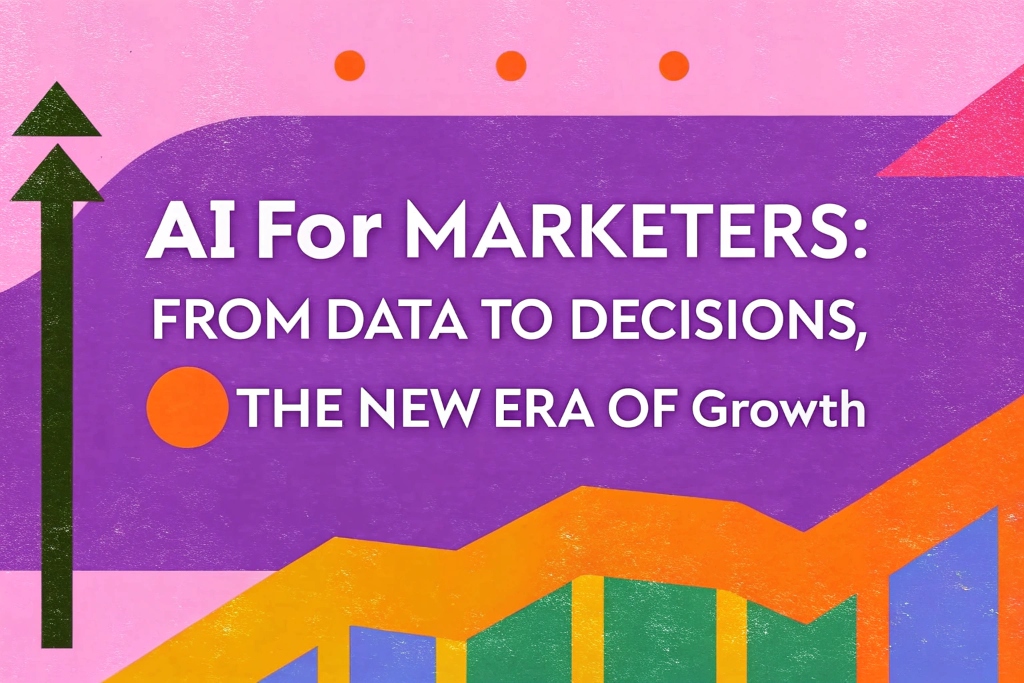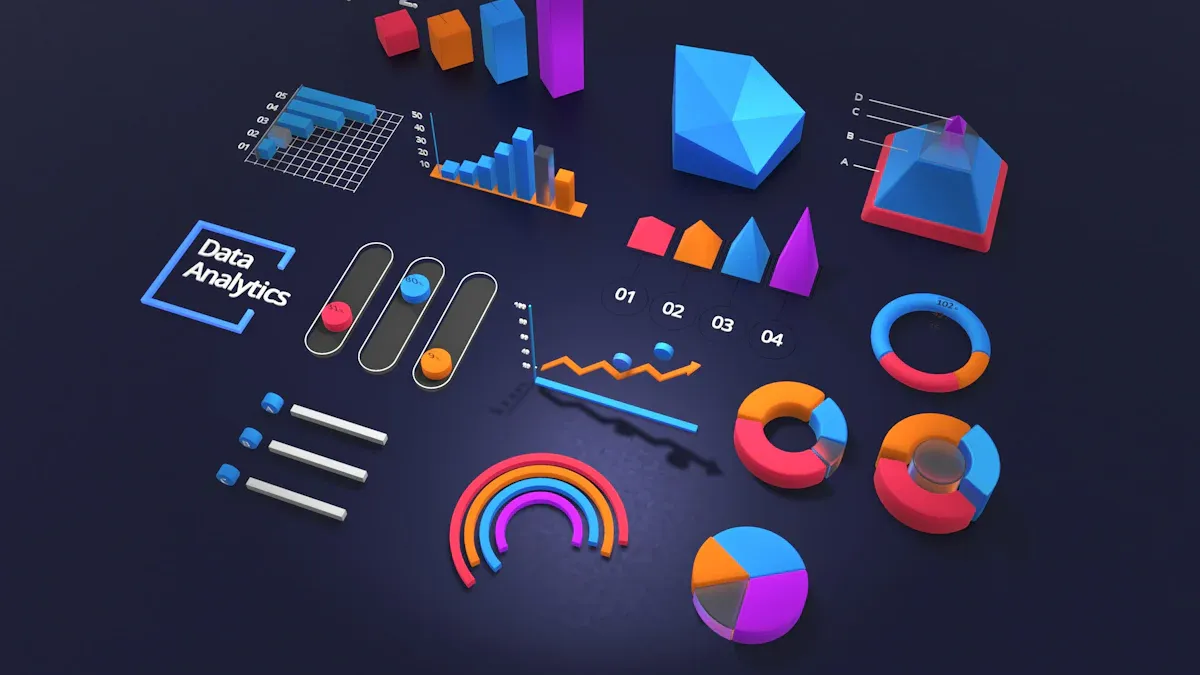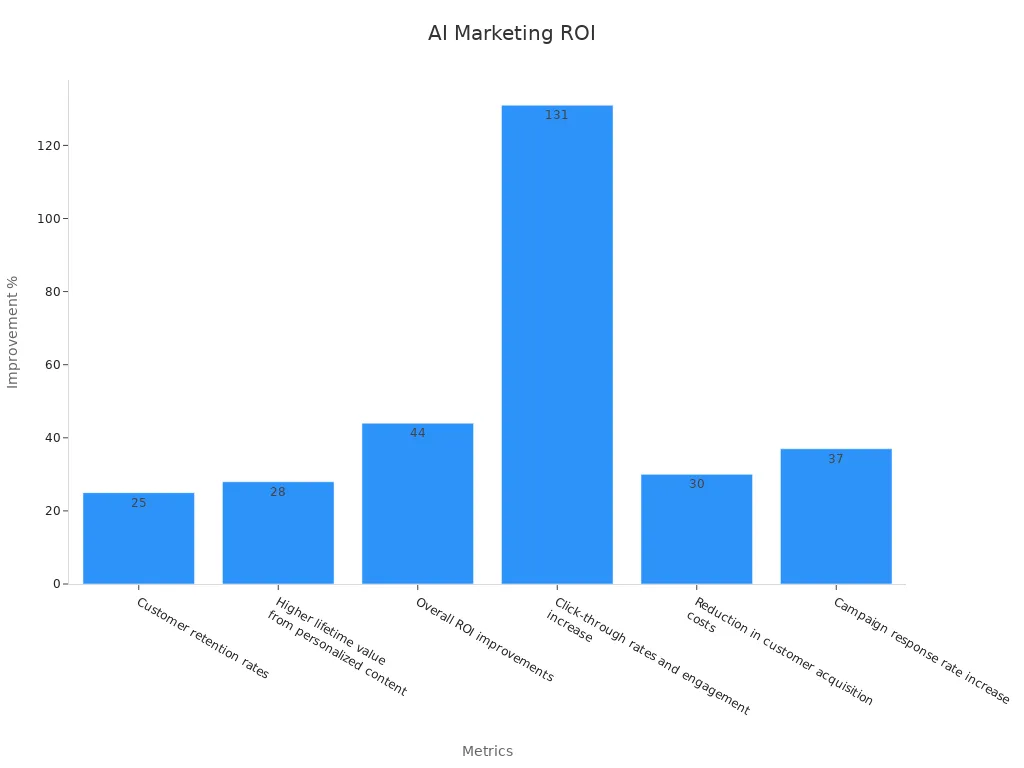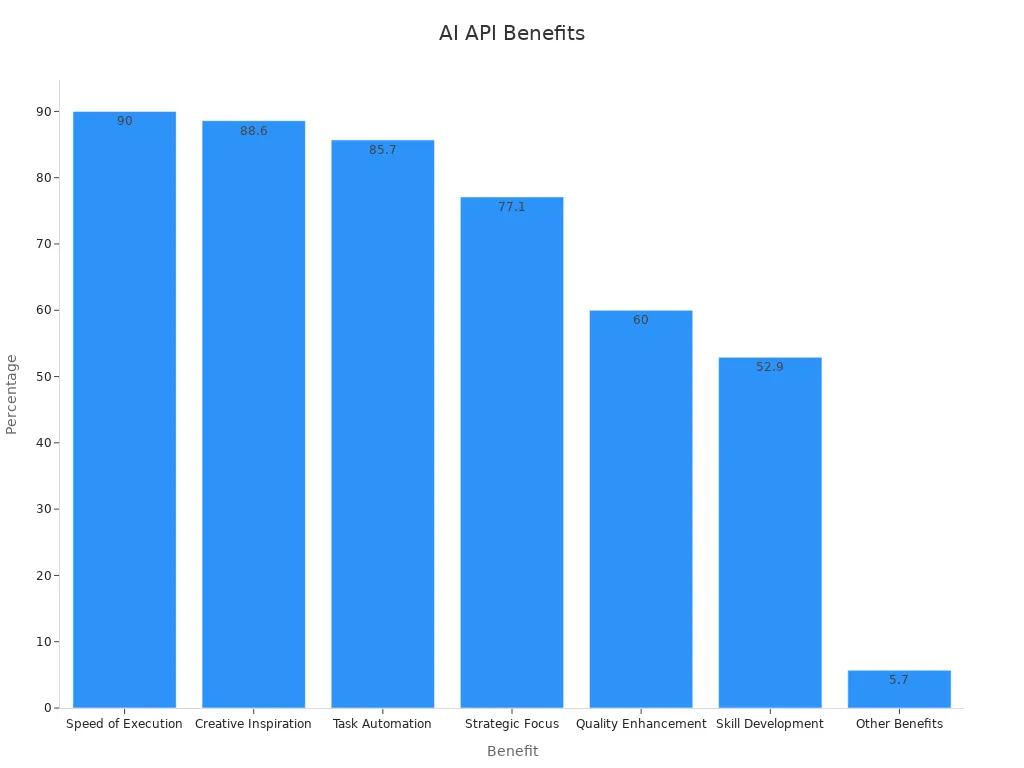AI for Marketers: From Data to Decisions, The New Era of Growth

Artificial intelligence is changing how marketing works, providing significant ai help marketing strategies. It assists in making smarter choices to grow businesses. Today, over 80% of marketers utilize AI to enhance online ads. In 2024, about 69.1% of marketers reported using AI, an increase from 61.4% the previous year. AI can analyze vast amounts of data, create personalized experiences, and optimize campaigns rapidly. The global AI marketing market is expanding by 25% each year, and by 2030, it may reach $82,234 million. AI help marketing teams remain competitive in the fast-evolving digital landscape.
Key Takeaways
AI is changing marketing by helping businesses make better choices.
Over 80% of marketers use AI to improve online ads.
AI tools study customer data, guess trends, and handle boring tasks.
This saves time and makes work faster and more effective.
AI-powered campaigns can make customers 40% more interested.
Using AI can launch campaigns 50% faster and cut content time by 30%-50%.
AI helps marketers learn about their audience through data study.
This leads to better targeting and smarter decisions.
AI adjusts campaigns quickly for better results in real-time.
Buying AI tools can increase profits and make customers happier.
Marketing's AI Evolution
Marketing's New Landscape
Marketing has changed a lot recently, thanks to AI. Tools now study customer actions, guess trends, and handle boring tasks. This makes marketing faster and more focused on customers.
AI tools like chatbots and trend predictors help marketers. They give personal suggestions and better guesses about trends, improving campaigns.
AI has also brought new ways to connect with people:
Smart programs find patterns in customer data to predict actions.
Chatbots and voice helpers use language tools for smooth chats.
AR shows products in real life, making shopping fun.
These tools help create campaigns that are smarter and more exciting.
Why AI is Essential for Growth
AI is now a must-have for marketers who want to grow. It finds chances, saves time, and works across many platforms. For instance, AI studies lots of data to spot trends and gaps. This helps you stay ahead and make smart choices.
Here’s how AI helps growth:
Content creation takes 30% to 50% less time.
AI also quickly studies data, helping you adjust to changes fast. This keeps your plans strong, even when things change. Using AI boosts profits and helps long-term success.
AI's Role in Data-Driven Decisions
Data is key in marketing, and AI turns it into useful ideas. AI studies customer actions, groups people, and predicts trends with great accuracy. This helps you make smart, data-based plans.
Trend | Evidence |
|---|---|
AI Automation | 83% of marketers work faster, and 50% save 1–5 hours weekly. |
Hyper-Personalization | 91% of shoppers prefer brands with personal experiences. |
AI-Powered Decision-Making | AI speeds up decisions by 78%, and predictions are 47% more accurate. |
Companies like Photobucket show AI's benefits. They answered faster by 14% and made customers 3% happier. These examples prove AI helps you make better, quicker choices for success.
Understanding AI in Marketing
What is AI in Marketing?
AI in marketing uses smart technology to improve customer understanding. It helps automate decisions and make marketing better. AI tools like machine learning (ML) and natural language processing (NLP) study data to find patterns. AI marketing includes:
Making customer experiences personal, like Netflix suggesting shows.
Using algorithms to guess trends and spot market changes.
Helping create content faster and easier.
These tools help marketers learn about customers and improve their work.
Key AI Capabilities for Marketers
Generative AI for Content Creation
Generative AI makes personalized marketing materials using customer data. It helps businesses stay ahead by saving time and effort. AI tools can write blogs, emails, and website text quickly.
Predictive AI for Forecasting
Predictive AI looks at past data to guess future trends. It helps set prices and score leads better. Knowing past actions helps plan smarter campaigns.
Conversational AI for Customer Engagement
Chatbots use conversational AI to talk with customers smoothly. They understand questions and give helpful answers. This improves customer service and satisfaction.
Analytic AI for Insights
Analytic AI studies big data to find useful patterns. It helps marketers make smart choices and saves time on boring tasks. This lets teams focus on important projects.
Personalization AI for Tailored Experiences
AI divides customers into groups based on interests and habits. This makes targeting better and campaigns more effective. Personalization AI gives custom suggestions, improving customer experiences.
Metric Type | Description |
|---|---|
Measuring Workflow Improvements | Metrics like faster processes and fewer mistakes show AI's impact. |
Tracking Financial Benefits | Metrics like ROI, cost savings, and revenue growth link AI to profits. |
Improving Customer Satisfaction | Metrics measure better service, happier customers, and loyalty. |
These AI tools make marketing smarter and more focused on customers.
AI Across the Marketing Funnel

Awareness & Lead Generation
Content Optimization with AI
AI tools check your content to make it better for readers. They find trends, improve headlines, and suggest changes for more clicks. For example, AI can pick keywords to rank higher in searches or adjust tone to fit your audience. This helps your content reach the right people at the right time.
AI makes messages more personal and content more relevant. This improves how well your campaigns work.
Audience Targeting and Segmentation
AI studies your audience's actions and likes to understand them better. It groups people by interests, age, and online habits. This helps you create personal experiences that get results. Predictive tools also guess what customers might do next, keeping you ahead.
AI tools help make smarter choices for better targeting.
Real-time data helps you act quickly and improve strategies.
Ad Campaign Automation
AI makes ad management easier by automating tasks like bidding and placement. It checks performance data to improve campaigns instantly, giving you the best results. AI tools also find good leads so you can focus on them.
AI improves email marketing by grouping leads based on their likes and actions. This makes emails more personal, increasing open and click rates to grow your audience.
Engagement & Nurturing
Personalized Customer Journeys
AI creates custom experiences by studying customer paths. It predicts what customers need and gives personal offers. This keeps people interested and builds trust.
Companies using AI can study big data well. This leads to smarter marketing plans and better strategies.
Conversational Marketing with Chatbots
AI chatbots talk to customers instantly, answering questions and helping them shop. They respond fast and keep communication smooth. Chatbots also sort leads and set up follow-ups, saving time.
Predictive Lead Scoring
AI checks leads to see who is most likely to buy. It uses past data to focus on the best prospects. This saves time and improves results.
AI tools rank leads, making it easier for teams to focus.
Predictive tools guess outcomes, helping you act on top leads early.
Conversion & Retention
Conversion Rate Optimization (CRO)
AI finds weak spots in your sales process. It tests ideas, studies customer actions, and suggests fixes to get more sales. For example, AI can recommend changes to landing pages or buttons to perform better.
Metric | Description |
|---|---|
Increased Conversion Rates | AI helps turn more leads into customers. |
Reduced Acquisition Costs | AI lowers costs by improving ad bidding. |
AI-Powered Customer Support
AI improves customer support by giving quick answers and personal help. Chatbots and virtual helpers handle questions fast, making customers happy. AI also reviews feedback to find ways to get better, keeping support up-to-date.
Loyalty Programs and Churn Prediction
AI helps keep customers by spotting those who might leave. It suggests rewards to keep them interested. AI studies actions to find at-risk customers and offers ways to keep them loyal. Personal loyalty programs make customers stay longer and feel valued.
Metric | Description |
|---|---|
Customer Retention Rate | AI helps keep customers and lowers the chance of losing them. |
Net Promoter Score (NPS) | AI improves customer happiness through better interactions. |
AI's Data-to-Decision Flow

AI for Data Management
Handling data well is key for great marketing. AI tools make this easier by keeping data correct and trustworthy. This helps you make better choices. The Data Quality Funnel Model shows why clean data matters. Using this model improves decisions and boosts campaign success.
AI also makes customer interactions better. For example:
It studies customer actions to find the best times to connect.
Tools like A/B Test Winner Auto-Selection show what works best.
AI chatbots use natural language processing (NLP) to give fast help.
Real-life examples show AI's power in managing data. Imagine Business Development uses AI to pick the best email times, doubling results. Whole Foods uses AI to track shopping habits and send personal deals. These examples show how AI can improve your marketing.
Example | Description | Impact |
|---|---|---|
Imagine Business Development | Uses AI to find the best email times for people. | Doubled email open rates and conversions. |
Whole Foods | Tracks shopping habits to send personal offers. | Better customer engagement with tailored messages. |
Gaining Deeper Insights with AI
AI helps you find answers that old methods miss. It looks at lots of data to find patterns and trends. This helps you know your audience better. Combining data from many places helps answer tough questions about what customers like.
For example, machine learning predicts what customers will do next. This helps you create products and campaigns they’ll love. Predictive tools also spot changes in customer likes, so you can adjust quickly.
Here’s how AI gives better insights:
It finds hidden trends, showing how customers feel.
It predicts future actions, keeping you ahead of others.
It keeps your plans useful in a fast-changing world.
Using AI helps you make smarter choices and create campaigns that connect with people.
Predictive Marketing Strategies
AI-powered predictive marketing helps you guess results and improve plans. By studying past data, AI finds patterns to guide your choices. This saves time and gets better results.
Companies using AI for predictive marketing see big gains. For example, AI content strategies raise marketing ROI by 20%. Campaigns using AI for content do 41% better at converting leads. AI tools also improve emails, with 59% more opens and 27% more clicks.
Statistic Description | Source |
|---|---|
McKinsey, 2022 | |
41% better conversion rates with AI content optimization | HubSpot Research, 2023 |
59% more email opens and 27% more clicks using AI journey mapping | Epsilon Marketing, 2023 |
Predictive marketing helps you focus on the best chances. It lets you use resources wisely and get better outcomes. With AI, you can build plans that grow your business and show clear success.
Automating Decision-Making
AI helps you make quicker and smarter choices by automating hard tasks. Instead of doing everything manually, AI tools study lots of data and suggest the best actions. This lets you focus on planning while AI handles the tough work. For example, AI can check customer habits, guess trends, and recommend changes to your campaigns—all instantly.
Automating decisions makes campaigns much better. Big companies like Coca-Cola show this. During the 2018 FIFA World Cup, Coca-Cola used AI tools to improve digital ads. This led to over 1.5 billion views and better brand awareness and sales. Also, AI-driven A/B testing during Diet Coke’s 2018 relaunch boosted brand favorability by 4% and helped sales grow. These examples show how AI can quickly improve marketing with smart, data-based choices.
Here’s how AI decision-making helps marketing:
Faster Adjustments: AI spots weak areas and suggests fixes right away.
Improved Accuracy: AI uses data, not guesses, to avoid mistakes.
Enhanced Efficiency: Automation saves time for creative and planning tasks.
Using AI in decisions keeps you ahead and gets better results with less effort.
Real-Time Campaign Optimization
AI helps campaigns perform their best by making instant changes. Old methods often take too long to analyze data, but AI works fast. It studies big datasets and adjusts campaigns based on results, improving their success.
For example, Euroflorist used AI to improve its website, raising conversion rates by 4.3%. Companies using AI in ads have seen a 76% boost in ROI and a 30% drop in customer costs. These results show AI helps target the right people and saves resources.
AI also makes ongoing changes. It watches campaigns and adjusts things like ad placement, audience targeting, and bids. This keeps campaigns strong, even when markets shift.
Tip: Try AI tools to test many campaign ideas at once. This shows what works best and lets you grow it fast.
Real-time optimization improves campaigns and makes customers happier. By sharing timely and relevant content, you build trust and get better results.
Tools to Help AI Marketing
AI-Powered Marketing Platforms
AI marketing platforms make hard tasks easier and improve results. These systems combine many AI tools to handle content and customer needs. They study data, automate boring tasks, and give useful tips. For example, tools like Salesforce Einstein and Adobe Sensei predict what customers want and make marketing more personal.
Using these platforms can greatly improve your success. Research shows companies using AI platforms see a 44% better ROI and keep 25% more customers. Personalized content from these tools can lead to six times more sales and a 131% rise in clicks.

These platforms save time and make campaigns better. They are essential for today’s marketers.
Specialized AI Tools for Marketers
Content Creation: Jasper, Copy.ai, Writesonic
Creating content is faster with Jasper, Copy.ai, and Writesonic. These tools write ads, blogs, and social posts in minutes. Jasper focuses on persuasive writing, while Copy.ai and Writesonic create various styles. Marketers using these tools save five hours weekly and finish content 84% faster.
SEO Optimization: Surfer SEO, Semrush, Clearscope
SEO tools like Surfer SEO, Semrush, and Clearscope help improve search rankings. They suggest keywords, track progress, and make your content easier to find. These tools bring more visitors to your site.
Chatbots: HubSpot Chatbot, Intercom, CustomGPT
Chatbots like HubSpot Chatbot, Intercom, and CustomGPT improve customer service. They answer questions fast, guide users, and find potential buyers. Businesses using chatbots see a 37% boost in responses and cut customer costs by 30%.
Visual Content: Midjourney, DALL-E, RunwayML
Visual tools like Midjourney, DALL-E, and RunwayML create amazing images and videos. These tools match your brand’s style and are great for ads, social posts, and product visuals.
Advertising: Google Ads AI, Smart Bidding Tools
AI tools like Google Ads AI and Smart Bidding Tools make ads better. They study data, adjust bids, and target the right audience. These tools help you spend less and earn more.
Tool | Pros | Cons | Suitability |
|---|---|---|---|
Tely AI | Creates content, improves SEO, affordable pricing | Needs setup time, less flexible | Great for small businesses wanting better promotions |
ChatGPT | Good for conversations, strong content creation | Needs fine-tuning, may give generic answers | Perfect for businesses needing interactive customer support and content |
Jasper | Expert in ad writing, easy to use | Costs more, may not fit all needs | Best for companies focused on persuasive marketing with a good budget |
Leveraging AI APIs
AI APIs let you add smart features to your systems. APIs like OpenAI, Google Cloud AI, and IBM Watson help with language, images, and predictions. These tools allow you to customize AI for your needs.
Using APIs has many benefits. They speed up work by 90%, spark creativity by 88.6%, and automate tasks by 85.7%. APIs let you focus on planning while AI handles the rest.

By using AI APIs, you can explore new ideas and stay ahead in marketing.
No-Code and Low-Code AI Tools
No-code and low-code AI tools change how marketing works. These platforms let you create AI solutions without coding skills. They simplify hard tasks, making AI easy for everyone. Even marketers with little tech knowledge can use them. This makes technology open to all, helping solve problems faster.
Full Stack Builder: Momen
Momen is a no-code tool for building apps easily. It combines design, logic, and databases in one place. You can quickly make AI-powered tools for marketing with Momen.
Tip: Use Momen to build dashboards for tracking campaigns or automate tasks like scoring leads.
Why Momen is great:
Drag-and-drop tools make app building simple.
Add AI features like chatbots or analytics without coding.
Teams can work together in real-time on the platform.
Momen saves time and money. It helps you focus on making tools that fit your marketing needs.
AI Workflows: N8n, Dify
N8n and Dify are tools for automating workflows. They connect apps and services to make marketing easier. These tools are perfect for saving time and boosting efficiency.
N8n:
N8n is open-source and automates tasks across different tools. For example, it syncs customer data between your CRM and email software. You can customize workflows to match your needs.
Dify:
Dify adds AI to workflows for tasks like analyzing data or creating content. It helps deploy AI models quickly to improve marketing strategies.
Tool | Key Features | Best For |
|---|---|---|
N8n | Open-source, customizable workflows | Automating multi-tool processes |
Dify | AI integration, user-friendly design | Enhancing AI-driven marketing |
Note: Both tools inspire creativity by letting you try new workflows. This encourages problem-solving and innovation in your team.
No-code and low-code tools like Momen, N8n, and Dify are transforming marketing. They let you use AI without needing IT experts. These platforms help you stay flexible, innovate fast, and match technology to your goals.
Challenges and Best Practices
Handling Ethical Issues
AI in marketing is powerful but comes with challenges. Problems like biased algorithms, privacy risks, and unfair practices can hurt your brand. For example, AI might treat some customer groups unfairly due to hidden biases. Also, using customer data means following strict rules like GDPR to stay responsible.
To solve these issues, focus on being clear and fair with AI use. Make rules for ethical AI and check your systems often for bias. Studies show that ethical AI helps with competition and innovation. By getting customer permission for data use and avoiding tricks, you can build trust and loyalty.
Tip: Add ethical rules to your AI plans to meet laws and customer needs.
Keeping Human Control
AI can do many tasks, but people are still needed. Humans ensure AI stays fair, accurate, and responsible. For example, fraud detection systems need people to set limits and make big decisions. Without human checks, AI might go against your brand’s values.
You can improve human control by reviewing AI decisions regularly. Train your team to understand AI and let them change decisions if needed. Experts say human input is key for fair AI use. A table below shows important points:
Evidence Description | Source |
|---|---|
Public institutions should justify algorithmic decision-making systems with evidence | Green 2022 |
Human decisions influence outcomes, such as setting thresholds for fraud detection | Agrawal et al. 2022 |
Governance processes must include adequate human review measures | Pinsent Masons 2022 |
Balancing AI and human input ensures your tools match your goals and values.
Fixing Integration Problems
Adding AI to your marketing systems can be tricky. Old systems, scattered data, and skill gaps make it harder. For instance, Munich Re struggled with money and skills when adding AI. They solved this by forming teams, training workers, and working with AI experts.
To fix these problems, start small with test projects before expanding. Check your data quality and use APIs to connect old and new systems. Partnering with AI companies can teach you new ideas. Also, train your team to use AI well.
Note: Tailor AI tools to your business needs. Avoid one-size-fits-all solutions for better results.
By solving these problems early, you can use AI fully and smoothly in your marketing.
Measuring ROI Effectively
Knowing how well your AI marketing works is important. It shows what’s working and what needs fixing. AI tools give clear numbers to prove their value. By using these numbers, you can make better choices and get the best results.
Metric | Description |
|---|---|
Better targeting and personal touches lead to more sales. | |
Customer Acquisition Cost (CAC) | Smarter marketing lowers CAC, meaning you spend less to gain customers. |
Customer Lifetime Value (CLTV) | AI boosts CLTV, showing customers are spending more over time. |
Engagement Metrics | Time spent on your site and social media activity show how well AI connects with customers. |
To check ROI, look at how much sales grow from AI use. Better audience grouping and smarter campaigns often cause this growth. Also, see how AI improves personal touches and customer experiences. For example, AI studies data to make chats and offers more meaningful.
Tip: Use AI tools to watch these numbers live. This helps you change plans fast and stay ahead of others.
By focusing on these results, you can prove how AI helps your marketing succeed.
Embracing Continuous Learning
AI changes fast, so staying updated is key. Learning all the time helps you and your team use AI better. It also keeps your marketing fresh and creative.
For example, a bank might hold AI training sessions for its staff. These lessons teach how to use AI tools well. Regular learning builds confidence and sparks new ideas, helping your team try new things in marketing.
Note: Ask your team to join webinars, online classes, or events. These give useful tips about new AI tools and smart ways to use them.
Learning more also helps you solve problems. As AI gets smarter, knowing how it works becomes more important. By teaching your team, you make sure they’re ready for tough challenges.
Always learning helps your team and improves your marketing. It shows you’re ready to use AI for long-term success.
AI helps you make better choices using data to grow. Adding AI to your marketing gives you an advantage and opens new doors. Businesses using AI see profits rise by 52% and customer conversions grow by 49%. Unilever uses AI chatbots to keep customers loyal. Coca-Cola improves ads by studying what people like for stronger connections. Begin with small steps, try different tools, and create solutions that fit your needs. With AI, you can improve ideas and succeed in a changing world.
FAQ
What is the main benefit of using AI in marketing?
AI helps you make better choices by studying data fast. It improves targeting, makes customer experiences personal, and handles boring tasks. This saves time and makes campaigns work better.
How can small businesses start using AI in marketing?
Start small with tools for simple tasks like writing or emails. Platforms like Jasper or Mailchimp are easy to use. Pick one area, test how it works, and grow slowly.
Does AI replace human marketers?
No, AI helps marketers by doing boring jobs and giving ideas. You still make creative plans and big decisions. Think of AI as a helper, not a replacement.
How does AI improve customer engagement?
AI makes chats personal by studying what customers do. Chatbots answer fast, and tools suggest products people might like. This makes customers happy and builds trust.
Are AI tools expensive for marketing?
Not all AI tools cost a lot. Many have cheap plans or free trials. For example, Canva and ChatGPT are good options for small budgets.
How do I measure the success of AI in my campaigns?
Check numbers like sales, costs, and customer activity. Use AI tools to watch these live. Change your plans based on the data to get better results.
Is AI difficult to integrate into existing systems?
It depends on your setup. Many AI tools have easy ways to connect, like APIs. Start with tools that match what you already use to make it simple.
How can I ensure ethical AI use in marketing?
Be clear about how you use data and follow privacy rules. Check AI often for unfair actions. Let people review AI decisions to keep things fair and build trust.
Tip: Always ask customers before using their data for AI campaigns.
See Also
A Founder's Handbook for Growth Through Public Building
18 Effective B2B SaaS Lead Generation Strategies for 2024
Creating an AI-Driven Reddit Marketing Tool for Automation

